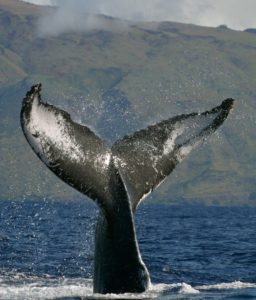 The humpback whale is a migratory species commonly known to make one of the longest migration trips of any animal. Humpback whales migrate twice a year during mating and feeding seasons. During feeding seasons, they can be found in cooler waters near the upper and lower hemisphere to stock up on food and replenish their blubber supply. During the mating and birthing season, they can be found in warmer waters towards the center of the equator. During their migration period, they will fast and live off of stored energy found in their blubber. Depending on their destination, they can travel up to 16,000 miles. For Northern Pacific humpback whales they feed in Alaska and travel to the Hawaiian Islands for mating season, typically between November and May. The majority of humpback whale sightings are between January and March, with February being the peak time. The journey from Alaska to the Hawaiian islands is roughly a 3,000-mile trek and can take as little as 36 days and up to 4-6 weeks one way at 3-7 miles per hour with very few stops. With Hawaii not having the distinct four seasons throughout the year, sighting humpback whales is one of the symbols that winter has arrived. Not only does Hawaii provide warmer waters, but it also allows for greater underwater visibility, a wide variety of ocean depths, and lacks natural predators. Humpback whales have an 11-12 month gestation period, which allows them to make one more migration to their feeding grounds before giving birth back in warm waters. During the Northern Pacific humpback whale’s time in Hawaii, calves will learn the behavioral and motor skills that will ensure their safety and livelihood necessary for survival during their long migration back to Alaska. These skills will ensure their survival against predators, with orcas, great white sharks, and tiger sharks being their main predators. As humpback whales are carnivores, they will feed on plankton, krill, and small fish such as mackerel, capelin, and herring. With humpback whales being the 5th largest whale species in the world, they weigh up to 50,000-80,000 pounds and can be up to 60 feet in length; they must consume up to 3,000 pounds of food a day to ensure a healthy weight.
The humpback whale is a migratory species commonly known to make one of the longest migration trips of any animal. Humpback whales migrate twice a year during mating and feeding seasons. During feeding seasons, they can be found in cooler waters near the upper and lower hemisphere to stock up on food and replenish their blubber supply. During the mating and birthing season, they can be found in warmer waters towards the center of the equator. During their migration period, they will fast and live off of stored energy found in their blubber. Depending on their destination, they can travel up to 16,000 miles. For Northern Pacific humpback whales they feed in Alaska and travel to the Hawaiian Islands for mating season, typically between November and May. The majority of humpback whale sightings are between January and March, with February being the peak time. The journey from Alaska to the Hawaiian islands is roughly a 3,000-mile trek and can take as little as 36 days and up to 4-6 weeks one way at 3-7 miles per hour with very few stops. With Hawaii not having the distinct four seasons throughout the year, sighting humpback whales is one of the symbols that winter has arrived. Not only does Hawaii provide warmer waters, but it also allows for greater underwater visibility, a wide variety of ocean depths, and lacks natural predators. Humpback whales have an 11-12 month gestation period, which allows them to make one more migration to their feeding grounds before giving birth back in warm waters. During the Northern Pacific humpback whale’s time in Hawaii, calves will learn the behavioral and motor skills that will ensure their safety and livelihood necessary for survival during their long migration back to Alaska. These skills will ensure their survival against predators, with orcas, great white sharks, and tiger sharks being their main predators. As humpback whales are carnivores, they will feed on plankton, krill, and small fish such as mackerel, capelin, and herring. With humpback whales being the 5th largest whale species in the world, they weigh up to 50,000-80,000 pounds and can be up to 60 feet in length; they must consume up to 3,000 pounds of food a day to ensure a healthy weight.
On average, 8,000-10,000 humpback whales visit the Hawaiian islands yearly for mating season. However, in the past years, whale sightings in Hawaii have become scarce. This may be due to numerous reasons, such as climate change or El Nino affecting water temperatures in other areas, making them change their migration patterns. A joint study by the Whale and Dolphins Conservation Society and the World Wildlife Fund found that rising sea temperatures can alter the whales’ normal mating and birthing areas. In 2015, the Christian Science Guide reported seeing humpback whales off the coast of Stamford in the Long Island Sound area for the first time in two decades. Another reason may be due to the increase in the whale population. A larger population competing for food can play a significant role in seeing humpback whales closer to the months of April and May rather than the typical January to March. A study found that the number of Northern Pacific humpback whales increased from 1,400 in 1966 to 21,000 in 2014. With the population growing, whales are staying in their feeding grounds for longer periods of time to compete for food in order to build up enough blubber to endure their long migration for mating season.
Our Halii Kai vacation rentals offer amazing views and in the winter months you can watch the whales from many of the vacation rentals lanais.
